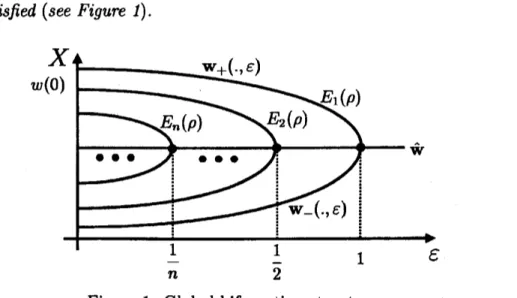135
Bifurcation structure
of stationary
solutions
of
a
Lotka-Volterra competition
model with
diffusion
Yukio Kan-On
Department
of
Mathematics, Faculty of EducationEhime University, Matsuyama, 790-8577, Japan kanon@ed.ehime-u.$\mathrm{a}\mathrm{c}$.Jp
In order to understand the mechanism ofphenomena in variousfields,
we
oftendiscuss theexistence andstabilityof stationary solutionsfor thesystem
ofreaction-diffusion equations
$1_{\mathrm{w}_{x}=0,x=0,1}^{\mathrm{w}_{t}=\epsilon^{2}D\mathrm{w}_{xx}+\mathrm{f}}(\mathrm{w})t’>0x\in(0,1)$
, $t>0,$
(1)
with suitable initialcondition, where $\mathrm{w}\in \mathrm{R}^{N}$,
$\epsilon$ $>0$, $D$ is a diagonalmatrix whose elements
are
positive, and $\mathrm{f}:\mathrm{R}^{N}arrow \mathrm{R}^{N}$ is smooth function.When $N=1$ is satisfied, we
can
comparatively easily study the existenceof stationary
solutions
for (1) and their spatial profile by the analysis ofmotions inthephase plane, becausethe sO-called comparisonprincipleholds.
Furthermore it is well-known that for suitable $f(w)$, the global attractor $A$
of (1) is represented
as
$A= \bigcup_{\epsilon\in E}W^{u}(e)$, where $E$ is the set of stationarysolutions for (1), and $W^{u}(e)$ is
an
unstable manifold of (1) at $w=e$ (forexample,
see
Hale [2, Chapter 4]$)$.
This factmeans
thatone
of importantproblems is to seek all stationary solutions of (1).
In general, the comparison principle does not always hold for the
case
$N\geq 2,$
so
we
have the considerable complexity for studying the existenceand stability of stationary solutions for (1). In this report, as
a
first step toapproach the problem for $N\geq 2,$
we
treat the stationary problem$\{\begin{array}{l}0=\epsilon^{2}d_{w}w’’+(\mathrm{l}-w^{n}-cz^{n})w0=\epsilon^{2}d_{z}z’,+(1-bw^{n}-z^{n})z,x\in(0,1)w’=0,z,=0,x=0,1\end{array}$ (2)
of
a
Lotka-Volterracompetitionmodel whichismostsimplewithintheffame-woth of
reaction-diffusion
equations, where $’= \frac{d}{dx}$, and every parameter isa
positive constant.As
$\mathrm{w}$means
the population density for two competingspecies,
we
restrictour
discussion topositivesolutions whichsatisfy$w(x)>0$and $z(x)>0$ for any $x\in[0,1]$
.
It is obvious that (2) hasconstant
solutions $(0, 0)$, $(0, 1)$, $(1, 0)$, and $\hat{\mathrm{w}}=$ (u),$\hat{z})$ with$\hat{w}=\sqrt[n]{\frac{1-c}{1-bc}}$, $\hat{z}=\sqrt[n]{\frac{1-b}{1-bc}}$
136
which is positive for $\max(b, c)<1$
or
$\min(b_{7}c)>1.$ Furthermore themax-imum principle leads to the fact that every solution of (2) with $w(x)\geq 0$
and $\mathrm{z}\{\mathrm{x}$) $\geq 0$ for any $x\in[0,1]$ must be
a
constant function in $x$, when$\min(b, c)<1$ is satisfied.
Let
us
consider thecase
$\mu=(b, c)\in$ $\mathrm{A}/\mathrm{f}$ $\equiv\{(b, c)|\min(b, c)>1\}$.
After
simple calculations,we see
that forany
$\mathrm{d}\in$ Vo(ji),the linearized
operator
of
(2)around
$\mathrm{w}=\hat{\mathrm{w}}$ has onlyone
eigenvalue and at least twoeigenvalues in the right half-plane for any $\epsilon$
with
$\epsilon$ $>1$ and $0<\epsilon<1,$respectively, where $R_{+}=$ $(0, +\mathrm{o}\mathrm{o})$, $\mathrm{d}=(d_{w}, d_{z})$, and
Vo(ji) $=$
{
$\mathrm{d}\in R_{+}^{2}|\det(-\pi^{2}D+$ fu(w)) $=0$}.
Thebifurcation theory says that nonconstant positive solutions of (2) which
look like $\pm \mathrm{v}$
case
$x>$ perturbations from $\mathrm{w}=\hat{\mathrm{w}}$ bifurcate at $\epsilon$ $=1$ for any
$\mathrm{d}\in$ Vo(ji), where$\mathrm{v}$ is
an
eigenvectorofthe linearized operatorcorrespondingtothe eigenvalue 0. As themulti-existence ofnonconstant positive solutions
for (2)
is
suggested,we
shall in thisreport establish the bifurcation structureofpositive solutions for (2) with respect to $\epsilon$ forarbitrarilyfixed $\mu\in \mathcal{M}$ and
$\mathrm{d}\in D_{0}(\mu)$
.
Let
us
prepare definitions and notations to state the main result of thisreport. We define the order relation $\preceq$ by
$(w_{1}, z_{1})\preceq(w_{2}, z_{2})\Leftrightarrow w_{1}\leq$ $<l\mathit{1}2$, $z_{1}\geq z_{2}$,
anddenote by $\prec$ the relationobtained from the above definition byreplacing
$<$ with $<$. Weset
$\rho=(\mu, \mathrm{d})$, $\mathrm{V}$
$=\cup\{\mu\}\mathrm{x}\mu\in \mathcal{M}$
$D_{0}(\mu)$, $E_{0}(\rho)=R_{+}$ $\mathrm{x}$ $\{\hat{\mathrm{w}}\}$,
$X=$
{
$\mathrm{w}(.)\in C^{2}([0,1])|$w’(0) $=0=$ w(x)}.For each $\rho\in N,$
we
denote by $\mathrm{E}(\mathrm{p})$ the set of $(\mathrm{e}, \mathrm{w}(.))\in R_{+}\mathrm{x}X$ suchthat $\mathrm{w}(x)$ is
a
positivesolution of (2)for
$\epsilon$, and by $E_{k}(\rho)(k\in \mathrm{N})$ the set of$(\epsilon, \mathrm{w}(.))\in$
E{p)
suchthat there exists$\ell\in\{0,1\}$ such that $(-1)^{j+\ell}\mathrm{w}’(x)\succ 0$is satisfied
for any $j\in \mathrm{Z}$ and $x\in$ (j/fc,$(j+1)/k$). By definition,we
see
that$\bigcup_{k\geq 0}$ Ek$(\mathrm{p})\subset E(\rho)$holds for any $\rho\in N$
,
and that for any $\rho\in II$and $k\in$ N,$(\epsilon, \mathrm{w}(.))$ $\in$ Ek(p) is equivalent to $(k \epsilon, \mathrm{w}(./k))$ $\in$ E(p).
Theorem 1. $E( \rho)=\bigcup_{k\geq 0}E_{k}(\rho)$ is
satisfied
for
any $n\geq 1$ and$\rho\in N.$The above theorem says that for each $n\geq 1$ and $\rho\in N,$
we
can
137
structure of$E_{1}(\rho)$. While the structure of Ei(p)
was
completely establishedfor the
case
$n=1$ in the previous paper [3], the following is for the case$n>2:$
Theorem 2. For each $n\geq 2$ and $\rho\in N,$ there exist continuous
functions
$\mathrm{w}$-(., g) and $\mathrm{w}_{+}($.,$\epsilon)$
defined
on
$(0, 1)$such that
(i) $E_{1}(\rho)=\{(\epsilon,\mathrm{w}_{\pm}(.,\epsilon))|\epsilon\in (0, 1)\}$,
(ii) 1$\mathrm{w}_{\pm}’(x, \epsilon)\prec 0$
for
any $x\in$ $(0,1)$ and $\epsilon$:
$(0, 1)$,and
(iii) $\lim_{\epsilonarrow}1$Wg$($.,$\epsilon)=\hat{\mathrm{w}}$.
are
satisfied
(see Figure 1).Figure 1. Global bifurcation structure.
In consideration of Chafee and Infante [1],
we
see
that the bifurcationstructure of positive solutions for (2) with respect to $\mathrm{e}$ for arbitrarily fixed
$n\geq 2$ and $\rho\in N$ is similarto that for
$\{$
$0=\epsilon^{2}u’’+u(1-u)(u-a)$, $x\in(0,1)$,
$u’(0)=0,$ $u’(1)=0,$
where $0<a<1.$ Furthermore it follows from Kishimoto and Weinberger [4]
that $\mathrm{w}_{-}($.,$\epsilon)$ and $\mathrm{w}_{+}(., \epsilon)$
are
unstablestatio.n
ary solutions for (1).Figure 2 (a)
and
(b)are
numericalbifurcation
diagramsof
$E_{1}(\rho)$ for thecase
where the assumption of Theorem 2 is violated, and show that thestructure of $E_{1}(\rho)$ depends
on
the interspecific competition rates $b$ and $c$ in138
$\sim_{\backslash \sim}$ . $\backslash$ 00 $-0^{\cdot}7^{\cdot}$ 0.,
, , (a) $b=c=$200.0
(b) $b=c=$2000.0
Figure 2. Bifurcation structure, where $n=1.1$ and $d_{w}=d_{z}$
.
In the proof of Theorem 2,
one
of important parts is to determine thegeometrical position of the
curve
of positive solutions for (2) bifurcatingfrom$\mathrm{w}=\hat{\mathrm{w}}$ at $\epsilon=1.$ In general, as the equation which describes the geometrical
position is very complex
even
ifwe
can
explicitly write down it,we
havedifficulty in analyzing the geometrical position theoretically. In theproof, to
determine the geometrical position,
we
employ the numerical verification bythe help
of
the intervalarithmetic
built into Mathematica.References
[1] N.Chafee and E. F. Infante, A
bifurcation
problemfor
a
nonlinearpartialdifferential
equationof
parabolic type, Applicable Anal. 4 (1974/75),pp.
17-37.
[2] J. K. Hale, “Asymptotic behavior of dissipative systems”,
American
Mathematical
Society, Providence, $\mathrm{R}\mathrm{I}$,1988.
[3] Y. Kan-On,
Global
bifurcation
structure
of
positive stationarysolutions
for
a
classical
Lotka-
Volterra competition model with diffusion, JapanJ.
Indust.
Appl. Math. 20 (2003), pp.285-310.
[4] K. Kishimoto and H. F. Weinberger, The spatial homogeneity
of
sta-$ble$ equilibria
